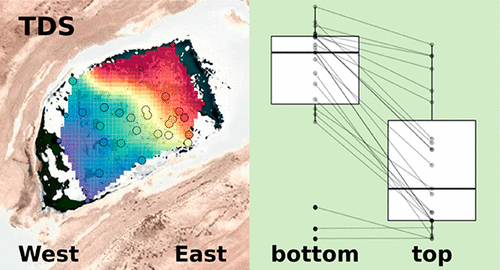当前位置:
X-MOL 学术
›
ACS Earth Space Chem.
›
论文详情
Our official English website, www.x-mol.net, welcomes your feedback! (Note: you will need to create a separate account there.)
Hydrochemical and Mineralogical Evolution through Evaporitic Processes in Salar de Llamara Brines (Atacama, Chile)
ACS Earth and Space Chemistry ( IF 3.4 ) Pub Date : 2020-05-20 , DOI: 10.1021/acsearthspacechem.0c00085 Fermín Otálora 1 , Joaquín Criado-Reyes 1 , Magi Baselga 1 , Angels Canals 2 , Cristobal Verdugo-Escamilla 1 , Juan Manuel García Ruiz 1
ACS Earth and Space Chemistry ( IF 3.4 ) Pub Date : 2020-05-20 , DOI: 10.1021/acsearthspacechem.0c00085 Fermín Otálora 1 , Joaquín Criado-Reyes 1 , Magi Baselga 1 , Angels Canals 2 , Cristobal Verdugo-Escamilla 1 , Juan Manuel García Ruiz 1
Affiliation

|
The study of extreme evaporitic environments is a subject of increasing interest in sedimentary petrology and planetary geology. We report here the evaporitic precipitation in the shallow, small lakes (puquı́os) at the Salar de Llamara (Atacama Desert, northern Chile). We have used a combination of in situ/laboratory/modeling methodologies allowing for the definition of a detailed, in-depth model for the sequence of evaporitic precipitation in the puquı́os. The in situ measurements in these ponds reveal that brines are density-stratified with important gradients in salinity, temperature, and other properties of the solution (pH, oxidation/reduction potential, and dissolved oxygen). These vertical gradients, along with the lateral and seasonal variations, are the main factors of chemical variability controlling the precipitation processes. The evaporation of these brines drives the chemical evolution of the different ions and produces two distinct mineral assemblages: (i) large structures made of millimetric to centrimetric-size crystals of gypsum often forming thrombolite-like or stromatolite-like morphologies in the ponds and (ii) salt crusts made of mainly gypsum, eugsterite, halite, and thenardite surrounding the ponds. Evaporation experiments in the laboratory monitored by in situ X-ray diffraction and optical videomicroscopy reveal a precipitation sequence in accordance with field observations but distinct from the thermodynamically predicted precipitation. The actual formation of eugsterite, rather than glauberite, and the observed delay in gypsum dissolution are explained using kinetic evaporation models.
中文翻译:

Salar de Llamara Brines(智利阿塔卡马)通过蒸发过程进行的水化学和矿物学演化
极端蒸发环境的研究对沉积岩石学和行星地质学越来越感兴趣。我们在此报告Salar de Llamara(智利北部阿塔卡马沙漠)的浅水小湖(puquı́os)中的蒸发降水。我们使用了原位/实验室/建模方法的组合,从而为puquı́os中的蒸发沉淀序列定义了详细的深度模型。在这些池塘中进行的现场测量表明,盐水被盐度,温度和溶液的其他特性(pH,氧化/还原电势和溶解氧)的重要梯度密度分层。这些垂直梯度以及横向和季节性变化是控制降水过程化学变化的主要因素。这些盐水的蒸发驱动着不同离子的化学演化,并产生两种截然不同的矿物组合:(i)由毫米级至厘米级石膏晶体制成的大型结构,通常在池塘中形成类似血栓石或层云母的形态,并且( ii)池塘周围主要由石膏,镁辉石,盐岩和芒硝制成的盐皮。在实验室中通过原位X射线衍射和光学显微镜观察的蒸发实验显示,根据现场观察,降水序列与热力学预测的降水不同。使用动力学蒸发模型解释了钙长石而不是钙长石的实际形成以及观察到的石膏溶解延迟。
更新日期:2020-06-18
中文翻译:

Salar de Llamara Brines(智利阿塔卡马)通过蒸发过程进行的水化学和矿物学演化
极端蒸发环境的研究对沉积岩石学和行星地质学越来越感兴趣。我们在此报告Salar de Llamara(智利北部阿塔卡马沙漠)的浅水小湖(puquı́os)中的蒸发降水。我们使用了原位/实验室/建模方法的组合,从而为puquı́os中的蒸发沉淀序列定义了详细的深度模型。在这些池塘中进行的现场测量表明,盐水被盐度,温度和溶液的其他特性(pH,氧化/还原电势和溶解氧)的重要梯度密度分层。这些垂直梯度以及横向和季节性变化是控制降水过程化学变化的主要因素。这些盐水的蒸发驱动着不同离子的化学演化,并产生两种截然不同的矿物组合:(i)由毫米级至厘米级石膏晶体制成的大型结构,通常在池塘中形成类似血栓石或层云母的形态,并且( ii)池塘周围主要由石膏,镁辉石,盐岩和芒硝制成的盐皮。在实验室中通过原位X射线衍射和光学显微镜观察的蒸发实验显示,根据现场观察,降水序列与热力学预测的降水不同。使用动力学蒸发模型解释了钙长石而不是钙长石的实际形成以及观察到的石膏溶解延迟。



























 京公网安备 11010802027423号
京公网安备 11010802027423号